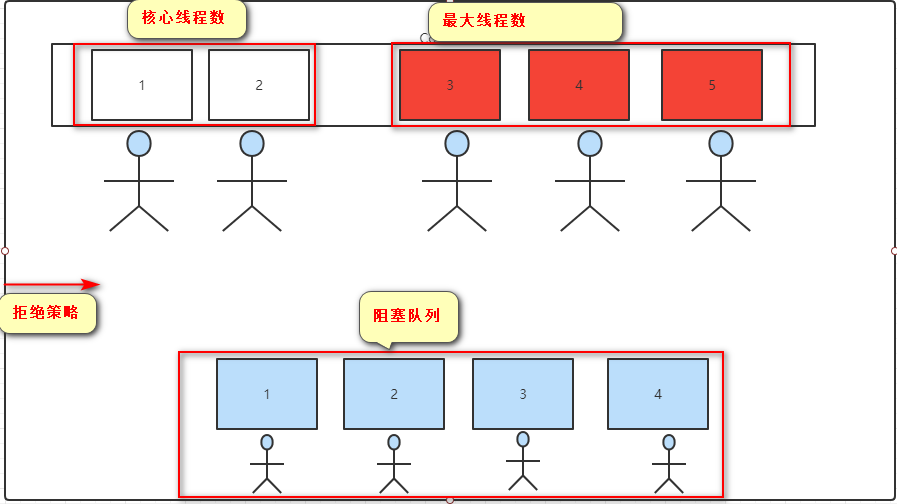6.线程池(重点)
线程池重点:
1.三大方法
2.7大参数
3.4种拒绝策略
池化技术:
程序的运行本质是:占用系统的资源!优化资源的使用==>池化技术
线程池、连接池、内存池、对象池等等 创建销毁十分浪费资源
池化技术:事先准备好一些资源,有人要用,就拿来用,用完归还
线程池的好处:
1.降低资源的消耗和浪费
2.提高响应的速度
3.方便管理
线程复用、可以控制并发数、管理线程
重点1:线程池的三大方法:Executors可以看做是线程池的一个工具类
1.单个线程
ExecutorService threadPool = Executors.newSingleThreadExecutor();
样例代码如下:
public class ThreadPool {
public static void main(String[] args) {
重点1:创建单个线程的线程池
ExecutorService threadPool = Executors.newSingleThreadExecutor();
try {
for (int i = 0; i < 10; i++) {
final int temp = i;
重点2:通过线程池启动线程:execute(Runnable)
threadPool.execute(()->{
System.out.println(Thread.currentThread().getName()+":"+temp);
});
}
} catch (Exception e) {
e.printStackTrace();
} finally {
threadPool.shutdown();
}
}
}
输出:发现至此只有一个线程在执行方法
pool-1-thread-1:0
pool-1-thread-1:1
pool-1-thread-1:2
pool-1-thread-1:3
pool-1-thread-1:4
...
2.创建固定大小的线程池Executors.newFixedThreadPool(5)
ExecutorService threadPool = Executors.newFixedThreadPool(5);
输出:发现同时最多有5个线程在执行
pool-1-thread-1:0
pool-1-thread-2:1
pool-1-thread-1:5
pool-1-thread-2:6
pool-1-thread-1:7
pool-1-thread-2:8
pool-1-thread-1:9
pool-1-thread-3:2
pool-1-thread-4:3
pool-1-thread-5:4
3.创建可伸缩的线程池:Executors.newCachedThreadPool()创建一个弹性的线程池,会根据cpu性能去创建对应的多个线程!
ExecutorService threadPool = Executors.newCachedThreadPool();
输出:发现同时最多有10个线程同时执行!
pool-1-thread-1:0
pool-1-thread-2:1
pool-1-thread-3:2
pool-1-thread-4:3
pool-1-thread-5:4
pool-1-thread-6:5
pool-1-thread-7:6
pool-1-thread-8:7
pool-1-thread-10:9
pool-1-thread-9:8重点2:7大参数
研究上述三大方法的源码:
1.newSingleThreadExecutor:单个线程的线程池
public static ExecutorService newSingleThreadExecutor() {
return new FinalizableDelegatedExecutorService
(new ThreadPoolExecutor(1, 1,
0L, TimeUnit.MILLISECONDS,
new LinkedBlockingQueue<Runnable>()));//未传入队列大小,则为Integer.maxValue
}
2.newFixedThreadPool:固定大小的线程池
public static ExecutorService newFixedThreadPool(int nThreads) {
return new ThreadPoolExecutor(nThreads, nThreads,
0L, TimeUnit.MILLISECONDS,
new LinkedBlockingQueue<Runnable>());//未传入队列大小,则为Integer.maxValue
}
3.newCachedThreadPool:可伸缩的线程池
public static ExecutorService newCachedThreadPool() {
return new ThreadPoolExecutor(0, Integer.MAX_VALUE,
60L, TimeUnit.SECONDS,
new SynchronousQueue<Runnable>());//单个的阻塞队列
}
发现三个方法底层都调用的是:ThreadPoolExecutor方法
public ThreadPoolExecutor(
int corePoolSize,//核心线程池大小
int maximumPoolSize,//最大核心线程池大小:包括核心线程池
long keepAliveTime,//超时时间:超时没人调用自动释放
TimeUnit unit,//超时时间单位
BlockingQueue<Runnable> workQueue,//阻塞队列
ThreadFactory threadFactory,//线程工厂,创建线程的,一般不用动
RejectedExecutionHandler handler//拒绝clue
) {
if (corePoolSize < 0 ||
maximumPoolSize <= 0 ||
maximumPoolSize < corePoolSize ||
keepAliveTime < 0)
throw new IllegalArgumentException();
if (workQueue == null || threadFactory == null || handler == null)
throw new NullPointerException();
this.corePoolSize = corePoolSize;
this.maximumPoolSize = maximumPoolSize;
this.workQueue = workQueue;
this.keepAliveTime = unit.toNanos(keepAliveTime);
this.threadFactory = threadFactory;
this.handler = handler;
}最大线程数=核心线程数+右边红色线程数

1.平时只有核心线程里的线程数在工作
2.但当请求增多,阻塞队列等待的已满,则最大线程数开始工作,来应对
3.但当线程数最大了,并且阻塞队列已满,再来请求执行拒绝策略重点3:自定义线程池已经几种阻塞策略使用
线程池的最大并发量=最大核心线程数+阻塞队列中的数量
1:第一种拒绝策略:AbortPolicy:当请求数大于最大并发数时,抛出异常!
1.1 并发数小于最大核心线程数:所以此时的情况是:核心线程处理两个请求,剩余三个在阻塞区等待,最大核心线程未启动!
public class ThreadPool {
public static void main(String[] args) {
重点1:创建自定义线程池
ExecutorService threadPool = new ThreadPoolExecutor(
2,//核心线程池数量
5,//最大线程池数
3,//超时时间,最大线程池里的线程超过时间无人调用时,归还线程资源
TimeUnit.SECONDS,//超时时间单位
new LinkedBlockingQueue<>(3),//阻塞队列:休息区的数量
Executors.defaultThreadFactory(),//默认的线程工厂
new ThreadPoolExecutor.AbortPolicy()//拒绝策略
);
try {
重点2:并发数小于最大核心线程数:所以此时的情况是:核心线程处理两个请求,剩余三个在阻塞区等待,最大核心线程未启动!
for (int i = 0; i < 5; i++) {
final int temp = i;
threadPool.execute(()->{
System.out.println(Thread.currentThread().getName()+":"+temp);
});
}
} catch (Exception e) {
e.printStackTrace();
} finally {
threadPool.shutdown();
}
}
}
输出:发现只有两个线程并发处理请求
pool-1-thread-1:0
pool-1-thread-2:1
pool-1-thread-1:2
pool-1-thread-2:3
pool-1-thread-2:4
1.2 并发数>核心线程数+阻塞线程数,最大核心线程启动,但是阻塞区依旧阻塞3个线程:
并发6个线程>核心线程数2+阻塞区线程数3,所以此时,最大线程区给出相差的1,此时有三个线程同时处理,剩余的阻塞区等待
for (int i = 0; i < 6; i++) {
final int temp = i;
threadPool.execute(()->{
System.out.println(Thread.currentThread().getName()+":"+temp);
});
}
输出:最大3个线程执行
pool-1-thread-1:0
pool-1-thread-2:1
pool-1-thread-2:2
pool-1-thread-2:3
pool-1-thread-2:4
pool-1-thread-3:5
1.3 并发数>最大线程数+阻塞线程数
此时并发数9>最大线程数5+阻塞区3,有一个线程无法访问资源,此时的拒绝策略:AbortPolicy会抛出异常!
try {
for (int i = 0; i < 9; i++) {
final int temp = i;
threadPool.execute(()->{
System.out.println(Thread.currentThread().getName()+":"+temp);
});
}
} catch (Exception e) {
e.printStackTrace();
} finally {
threadPool.shutdown();
}
输出:
pool-1-thread-1:0
pool-1-thread-1:2
pool-1-thread-1:3
pool-1-thread-1:4
pool-1-thread-2:1
pool-1-thread-3:5
pool-1-thread-4:6
pool-1-thread-5:7
java.util.concurrent.RejectedExecutionException
2.第二种拒绝策略:CallerRunsPolicy,哪来的回哪去
ExecutorService threadPool = new ThreadPoolExecutor(
2,//核心线程池数量
5,//最大线程池数
3,//超时时间,最大线程池里的线程超过时间无人调用时,归还线程资源
TimeUnit.SECONDS,//超时时间单位
new LinkedBlockingQueue<>(3),//阻塞队列:休息区的数量
Executors.defaultThreadFactory(),//默认的线程工厂
new ThreadPoolExecutor.CallerRunsPolicy()//拒绝策略:哪来的回哪去
);
try {
for (int i = 0; i < 9; i++) {
final int temp = i;
threadPool.execute(()->{
System.out.println(Thread.currentThread().getName()+":"+temp);
});
}
} catch (Exception e) {
e.printStackTrace();
} finally {
threadPool.shutdown();
}
输出:发现超出的线程由调用的main线程执行了!
pool-1-thread-1:0
main:8
pool-1-thread-2:1
pool-1-thread-1:2
pool-1-thread-2:3
pool-1-thread-1:4
pool-1-thread-4:6
pool-1-thread-5:7
pool-1-thread-3:5
3.DiscardPolicy:丢弃任务,不会抛出异常!
ExecutorService threadPool = new ThreadPoolExecutor(
2,//核心线程池数量
5,//最大线程池数
3,//超时时间,最大线程池里的线程超过时间无人调用时,归还线程资源
TimeUnit.SECONDS,//超时时间单位
new LinkedBlockingQueue<>(3),//阻塞队列:休息区的数量
Executors.defaultThreadFactory(),//默认的线程工厂
//DiscardPolicy的拒绝策略,丢弃任务,不会抛出异常!
new ThreadPoolExecutor.DiscardPolicy()//拒绝策略
);
try {
for (int i = 0; i < 9; i++) {
final int temp = i;
threadPool.execute(()->{
System.out.println(Thread.currentThread().getName()+":"+temp);
});
}
} catch (Exception e) {
e.printStackTrace();
} finally {
threadPool.shutdown();
}
输出:发现5个线程同时执行,多出的那个线程被丢弃!
pool-1-thread-1:0
pool-1-thread-4:6
pool-1-thread-3:5
pool-1-thread-2:1
pool-1-thread-4:2
pool-1-thread-5:7
pool-1-thread-4:4
pool-1-thread-1:3
4.DiscardOldestPolicy:队列满了是,尝试和最早的线程竞争,也不会抛出异常!
ExecutorService threadPool = new ThreadPoolExecutor(
2,//核心线程池数量
5,//最大线程池数
3,//超时时间,最大线程池里的线程超过时间无人调用时,归还线程资源
TimeUnit.SECONDS,//超时时间单位
new LinkedBlockingQueue<>(3),//阻塞队列:休息区的数量
Executors.defaultThreadFactory(),//默认的线程工厂
new ThreadPoolExecutor.DiscardOldestPolicy()//拒绝策略
);线程池的最大的大小如何设置呢
池的最大的大小如何设置?(调优)
1.IO密集型:判断你程序中什么耗资源的IO线程,让后将最最大值设为其2倍
2.CPU密集型:几何cpu就设置为几,可以保证CPU效率最高
一般都是代码获取cpu核数
Runtime.getRuntime().availableProcessors();





【推荐】国内首个AI IDE,深度理解中文开发场景,立即下载体验Trae
【推荐】编程新体验,更懂你的AI,立即体验豆包MarsCode编程助手
【推荐】抖音旗下AI助手豆包,你的智能百科全书,全免费不限次数
【推荐】轻量又高性能的 SSH 工具 IShell:AI 加持,快人一步
· Manus重磅发布:全球首款通用AI代理技术深度解析与实战指南
· 被坑几百块钱后,我竟然真的恢复了删除的微信聊天记录!
· 没有Manus邀请码?试试免邀请码的MGX或者开源的OpenManus吧
· 园子的第一款AI主题卫衣上架——"HELLO! HOW CAN I ASSIST YOU TODAY
· 【自荐】一款简洁、开源的在线白板工具 Drawnix